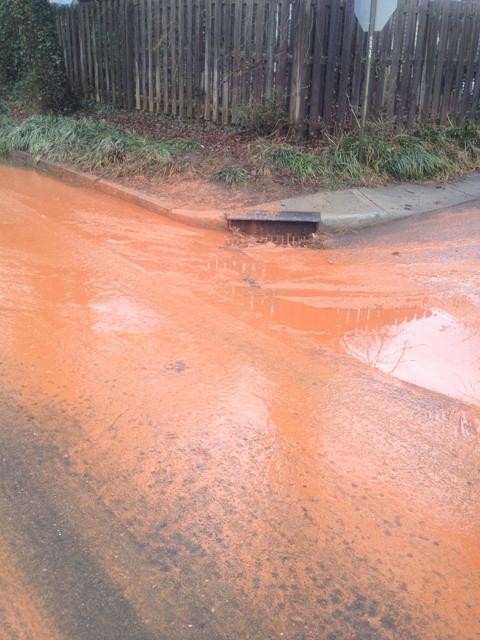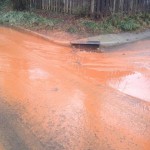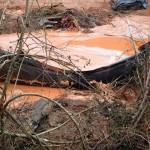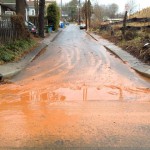- Dirt in the streets: On Jan. 11, rainfall led to dirt and sediment washing through the streets of the Five Points neighborhood near the Chick-fil-A site. Photo by Heather Rayburn
- Photo by Heather Rayburn
- Photo by Ben Gillum
- A major concern: According to city staff, erosion runoff is the No. 1 pollutant in local waterways, and can make driving less safe.
The latest round in a long-running neighborhood dispute highlights the uneasy truce between the conflicting aims of environmental protection and development. On Jan. 11, heavy rains pounded Asheville. But in Five Points, it wasn't only water coursing through the streets. The deluge sent mud and debris from the nearby AAA/Chick-fil-A construction project running down the residential neighborhood’s thoroughfares and side roads. The construction site is part of the large Merrimon Avenue development anchored by the new Harris Teeter grocery.
Residents, many of whom have long been concerned about the project’s impact, say this shows that the city's enforcement of the current erosion-control ordinance is too lax and that more stringent rules are needed.
Sediment is the No. 1 pollutant entering the region’s waterways, says Shannon Tuch, the city’s director of development services, and it can also pose traffic hazards by making roads slick.
City staff, finding that contractor Beverly-Grant hadn’t adequately prepared for such a downpour, swiftly fined the company the maximum amount allowed. And in a Jan. 14 email to community activists, Tuch noted her "frustration" with developers trying to excuse such erosion as something they couldn't prepare for. But she also pointed out that these are tricky issues to address, and that, in any case, changing the ordinance wouldn’t be easy.
Beverly-Grant, meanwhile, says it did and will continue to do everything the city requires. In an email to Xpress, project manager J. Chris Smith wrote: “The civil engineer of record for this project submitted an engineered erosion-control plan to the city which was accepted and approved … in conjunction with the issuance of our grading permit. … The city inspected the project site on Jan. 8 and found it to be in full compliance with the requirements of our grading permit. Their inspection determined that all required erosion-control measures had been installed and were being properly maintained. Following the event on the 11th, additional erosion-control measures were installed at the direction of the civil engineer of record for the project, [who] is currently working with the city to evaluate whether further design changes are necessary. Beverly-Grant and its subcontractors are committed to maintaining sediment on our projects and will continue to cooperate with all parties involved.”
Mud in the streets
"There was quite a bit of red mud at the intersection of Eloise Street and Holland Street," resident Ben Gillum recalls. "This is the second time within a month that we've had significant erosion runoff there."
"It wasn't even that big of a rainstorm; it shouldn't be enough to overwhelm erosion control," he adds. "I'd like it to be fixed, and I'd like punitive measures to be taken; they're harming the public good."
Photos provided by Gillum and Heather Rayburn, an activist and longtime resident who’s active in the 5 Points Neighborhood Association, show dirt and debris flowing across nearby streets. And Gillum maintains that the $2,000 fine issued is not enough to get the attention of a major company like Beverly-Grant that's working on a multimillion-dollar project.
Tuch’s lengthy email to residents states that on Jan. 8, staff "found the site was in compliance … and no issues or weaknesses were noted." But the "severe rain event" three days later caused "several erosion-control failures in the area." On Jan. 13, staff investigated again, concluded that a "moderate" violation had occurred, and fined Beverly-Grant, while also requiring the company to install better safeguards.
Normally, staff allow contractors some time to fix the problem before levying a fine, noted Tuch. But when sediment overflows a site's boundaries, a fine can be issued immediately. Beverly-Grant had previously been charged with three erosion violations while building the Harris Teeter portion of the project, including two immediate fines and one notice to resolve an issue.
Tuch also discussed what the city requires (emphases in the original):
“It is frustrating to our staff to hear a developer say, ‘We did everything the city required us to do.’ This is false. The requirement is that the developer and other responsible parties maintain their erosion-control measures and that the site remain secure — they are not permitted, nor does the city allow, off-site sedimentation or impacts to streams. That means the developer or owner needs to do whatever is necessary to ensure that this does not happen — the responsibility is entirely theirs. This is repeatedly confused with the minimum standards that are required by the city, which are influenced heavily by statewide standards. Those standards are designed to withstand a typical storm event, which works very well 90 percent of the time, especially if there is some vigilance from the contractor. Meeting a minimum design standard does not excuse a developer from the responsibility of keeping his/her site secure and safe. If they did everything we required them to do, they would not be receiving a fine and [notice of violation].”
Asked for clarification, Tuch later told Xpress: “A construction site isn't static. There's a need for vigilance.” Developers, she explained, must watch the weather and make sure the erosion-control measures continue to work as intended.
Politics and pragmatism
The Jan. 11 incident is "just the latest in a multitude of problems we've had over the last several years," says Gillum. And in one of her emails, Rayburn cited "continual abuse of our neighborhood and the environment.” When City Council was considering whether to approve the project, many residents raised objections, citing concerns about increased traffic and runoff.
Meanwhile, Tuch has cautioned those demanding stronger regulations that changing the rules is no simple task. When the city considered the last round of revisions in 2010, there were serious debates over whether the proposed changes were enforceable and how best to balance environmental protection with the need for development.
For her part, Rayburn says she just wants the developers "to be good neighbors." And in a Jan. 13 email to Tuch, Rayburn elaborated some of the residents’ concerns:
“This mud is going straight into the storm system and then into Reed Creek and on into the French Broad River. The mud removes oxygen from the waterways, which kills fish and other aquatic life. The sediment also settles in between rocks on the water beds and interferes with fish spawning. Birds depend on the fish for food, and people downriver depend on the French Broad for drinking water. … This stuff matters.”
But Tuch, who played a major role in crafting the current rules, also stated in her Jan. 14 email to the residents: "To design and adopt stronger stormwater standards would present some challenges. This would require balancing all considerations, including those of the development community, that would weigh benefits gained versus costs incurred. This was thoroughly vetted during the process to adopt the current standards. Of course values and needs change over time and it is appropriate to reconsider, but for those of us who participated in this the first time, it is no small undertaking."
To further muddy the waters, the North Carolina Legislature has seriously considered eliminating local stormwater review entirely and prohibiting any local regulations more stringent than statewide requirements (which would scale back even Asheville's existing rules). This, noted Tuch, has left staff reluctant to begin an overhaul that might be entirely undone by a single action in Raleigh.
In a Jan. 13 email to city staff, Rayburn had expressed some skepticism about how well the current system works, writing, "This has gone on for, what? Two years for our neighborhood. The runoff requirements are insufficient, and the fines are too rare and too low to matter. The ordinances aren't reflecting the reality on the ground. I keep reporting this stuff, and it keeps happening over and over. Super frustrating that nothing seems to change for the better."
In a subsequent email to Xpress, however, Rayburn stressed that despite her frustrations, she was pleased with the city's response to the latest incident and believes they're doing their best in a tricky situation, given the current rules. "They don't like to see pollution clogging up the stormwater system and waterways any more than we do. They have this site on their radar, and they've become very responsive when we call to report a violation."
And Tuch, conceding that developing a site near major roads in an urban area is particularly challenging, says she believes Beverly-Grant is "really trying."
— David Forbes can be reached at 251-1333, ext. 137, or at dforbes@mountainx.com.








Thanks for the well-written coverage of this issue. Here are some videos of the mess this development has caused our neighborhood, stormwater system, and waterways:
1-30-13: https://vimeo.com/59199419
7-3-13: https://vimeo.com/69673674
7-10-13: https://vimeo.com/70082474
These are just three separate days caught on video. There are many other times recorded with photos. I strongly disagree with Shannon that Beverly-Grant is “really trying.” If they were, this wouldn’t keep happening over and over and over again.
I feel very pessimistic about the future of our environment, especially given the push by privateering radicals in the NC statehouse trying to eviscerate what tiny and inadequate protections cities currently have to safeguard the public good from polluters.
Drew Emanuele